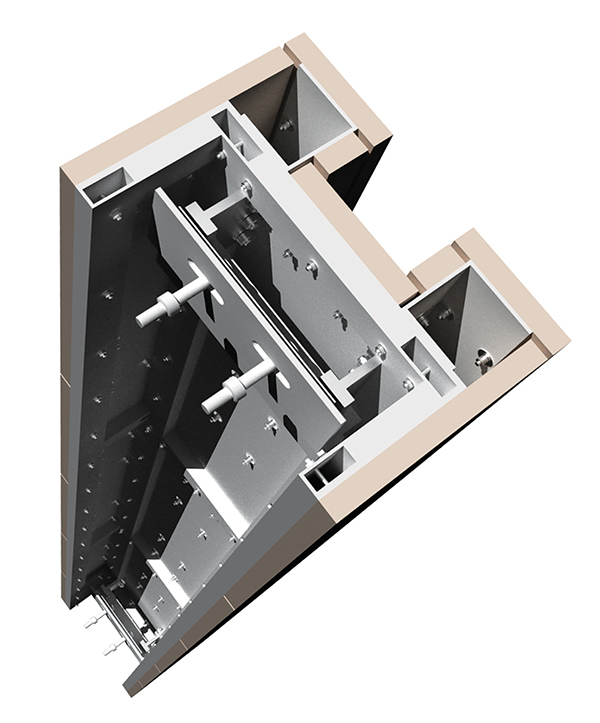
A three-storey rooftop office extension in London’s City was delivered with the help of prefabricated facade panels. CM reports.
Modern methods of construction (MMC) are typically associated with new build but they have plenty of applications in refurbishment too, as Mace demonstrated recently on a City of London office revamp and extension.
The company’s £58m Gresham St Paul’s project for Stanhope and AFIAA Real Estate Investment is an example of how to achieve programme and quality benefits from prefabrication, with the project team pinpointing which elements of the build could be prefabricated during the planning stages.
Project details: Gresham St Paul’s
Value: £58m
Programme: 24 months
Client: AFIAA Real Estate Investment/ Stanhope
Architect: Wilkinson Eyre
Engineer: Waterman
Main contractor: Mace
Subcontractor: GIG Fassaden
The project involved the transformation of a seven-storey office building on Gresham Street in the heart of the City, delivering a Cat A, BREEAM Excellent development. Designed by Wilkinson Eyre, it included a three-storey rooftop extension with engineered stone cladding to complement the Portland stone facades of the original building.
The Mace team was keen to consider how the benefits of a precision-manufactured cladding system could be maximised as a modular installation to drive buildability advantages for both cost and programme management.
“We had previously taken a unitised module approach to the facade installation at a similar project, working with the same facade specialist, GIG Fassaden,” explains Michael Adams, facade lead (commercial offices) at Mace. “We were confident that the same approach could deliver comparable advantages in terms of quality, consistency, programme management and cost reduction for this project.
“We knew close collaboration between our team, GIG Fassaden and manufacturer Shackerley would be central to a successful outcome for this element of the project.”
Drivers for modular
Among the key drivers of a modular approach were the advantages provided by striking the scaffold as early as possible. The scaffold was necessary for upgrading the retained facade. Removing it early and craning prefabricated cladding modules into place for the high-level extension had both cost and operational benefits.

“Our approach to prefabrication is always to consider the whole project benefit: the procurement costs of this route can sometimes be higher, but that can be more than offset by the reduction in site costs,” Adams explains.
“It also reduces risk, because it gives us more control and consistency. With a conventional cladding installation, if just one component is missing from a delivery, it can cause a delay, but with this project we knew every module arriving on site was complete and installation ready.
“That was a major benefit of working with Shackerley because they have ISO 9001-accredited UK factories, so we were able to visit them several times and ensure that their QA processes were aligned to the exacting tolerances required on site.”
The facade design specified Shackerley’s SureClad engineered stone system in a creamy beige ‘Valpolicella’ with a sandblasted finish for the additional storeys, to reference the materiality of the lower storeys and answer planning requirements.
The cladding system for the new storeys also had to work within the loading parameters of the original structure and the large format 3050 x 1240mm SureClad panels were just 30mm thick, providing a lightweight solution.
Facade contractor GIG Fassaden designed the modular installation and fabricated the aluminium frames for the unitised modules. The initial plan was for Shackerley’s SureClad engineered stone panels to be shipped to the facade specialist in Austria then delivered back to site in London. However, there were considerable cost, programme management and sustainability benefits to having the modules built at one of Shackerley’s UK factories.
Thomas Thaller from GIG Fassaden explains: “It was clear that Shackerley had the technical expertise and manufacturing capabilities to fabricate the modular units to our design. This provided an ideal solution that fits with the sustainability goals of the BREEAM Excellent project by reducing embedded carbon, while allowing close co-ordination of each aspect of the fabrication in a single, quality-assured factory.”

Working closely with GIG Fassaden and Mace, Shackerley fabricated 400 modular facade units. The custom-designed modular units utilise Shackerley’s undercut anchor and bolt fixing system, but the panels were secured directly onto the frames supplied by GIG Fassaden, creating 4m columns, each with 35 sections of engineered stone, including front panels and side returns.
Thaller continues: “It was a technically complex requirement but the Shackerley team worked with us on the design and produced a sample so we could trial the solution and provide an accurate costing for both materials and fabrication.”
The bracketry for the system was also designed and manufactured by GIG Fassaden and fixed to the building.
“When each engineered stone module arrived on site, it was craned into position and bolted onto the substructure,” Adams says.
“With a conventional installation, a typical bay would have taken around a fortnight to install, but each bay could be completed in a day using this approach. It not only reduced the programme but made it more predictable because we knew the modules were installation ready and accurately aligned.”
The project articulates the benefits of collaboration across the supply chain. “The benefits are not only clear in the programme,” Adams adds, “but also in the finished facade with the absolute uniformity of the panels.”










